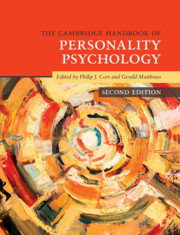Book contents
- The Cambridge Handbook of Personality Psychology
- Cambridge Handbooks in Psychology
- The Cambridge Handbook of Personality Psychology
- Copyright page
- Contents
- Figures
- Tables
- Contributors
- Preface
- General Introduction
- Part I Foundational Issues: History and Approaches to Personality
- Part II Description and Measurement: How Personality Is Studied
- Part III Development, Health and Change: Life Span and Health Outcomes
- Part IV Biological Perspectives: Evolution, Genetics and Neuroscience of Personality
- 16 Evolutionary Personality Psychology
- 17 Personality in Nonhuman Animals
- 18 Genetics of Personality
- 19 Approach–Avoidance Theories of Personality
- 20 Personality Neuroscience
- Part V Cognitive and Motivational Perspectives: Dynamic Processes of Personality
- Part VI Social and Cultural Processes: Personality at the Intersection of Society
- Part VII Applications of Personality Psychology: Personality Traits and Processes in Action
- Addendum: Statistical Analyses and Computer Programming in Personality
- Index
- References
16 - Evolutionary Personality Psychology
from Part IV - Biological Perspectives: Evolution, Genetics and Neuroscience of Personality
Published online by Cambridge University Press: 18 September 2020
- The Cambridge Handbook of Personality Psychology
- Cambridge Handbooks in Psychology
- The Cambridge Handbook of Personality Psychology
- Copyright page
- Contents
- Figures
- Tables
- Contributors
- Preface
- General Introduction
- Part I Foundational Issues: History and Approaches to Personality
- Part II Description and Measurement: How Personality Is Studied
- Part III Development, Health and Change: Life Span and Health Outcomes
- Part IV Biological Perspectives: Evolution, Genetics and Neuroscience of Personality
- 16 Evolutionary Personality Psychology
- 17 Personality in Nonhuman Animals
- 18 Genetics of Personality
- 19 Approach–Avoidance Theories of Personality
- 20 Personality Neuroscience
- Part V Cognitive and Motivational Perspectives: Dynamic Processes of Personality
- Part VI Social and Cultural Processes: Personality at the Intersection of Society
- Part VII Applications of Personality Psychology: Personality Traits and Processes in Action
- Addendum: Statistical Analyses and Computer Programming in Personality
- Index
- References
Summary
Historically, psychology has been characterized by a dichotomy between branches that focus on human nature and those that focus on individual differences. Initial “grand theories” of personality, such as those advanced by Freud, Maslow and others, were interested in universal psychological features. For Freud, the emphasis was on sexual and aggressive “instincts” and a universal sequence of psychosexual stages. For Maslow, the focus was on a hierarchy of universal psychological needs, from immediate physiological demands to “self-actualization.” Historically, personality psychology has been the primary branch that has aspired to such broad conceptualizations of human nature.
- Type
- Chapter
- Information
- The Cambridge Handbook of Personality Psychology , pp. 223 - 234Publisher: Cambridge University PressPrint publication year: 2020
References
- 8
- Cited by

